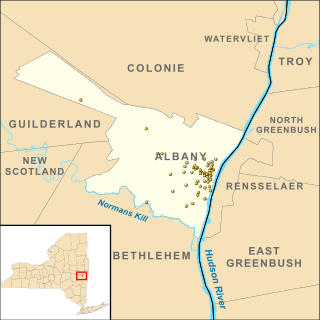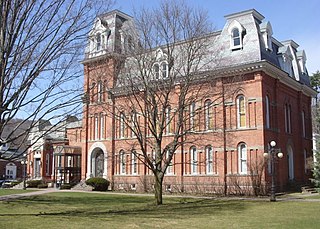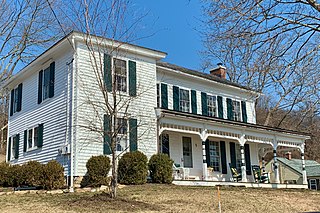
Marshallton is an unincorporated community in Mill Creek Hundred, New Castle County, Delaware, United States. The community was founded in 1836 and is named for John Marshall, mill owner.

Harlan & Hollingsworth was a Wilmington, Delaware, firm that constructed ships and railroad cars during the 19th century and into the 20th century.

SUNY Plaza, or the H. Carl McCall SUNY Building, formerly the Delaware & Hudson Railroad Company Building, is a public office building located at 353 Broadway at the intersection with State Street in downtown Albany, New York, United States. Locally the building is sometimes referred to as "The Castle" or "D&H Plaza"; prior to the construction of the nearby Empire State Plaza it was simply "The Plaza". The central tower of the building is thirteen stories high and is capped by an 8-foot-tall (2.4 m) working weathervane that is a replica of Henry Hudson's Half Moon.

Heislerville is an unincorporated community located in Maurice River Township of Cumberland County, New Jersey. It was named after the Heisler family, prominent members of the Methodist Episcopal Church established here in 1828.

The Monroe Avenue Commercial Buildings, also known as the Monroe Block, is a historic district located along a block-and-a-half stretch at 16-118 Monroe Avenue in Detroit, Michigan, just off Woodward Avenue at the northern end of Campus Martius. The district was designated a Michigan State Historic Site in 1974 and listed on the National Register of Historic Places in 1975. The thirteen original buildings were built between 1852 and 1911 and ranged from two to five stories in height. The National Theatre, built in 1911, is the oldest surviving theatre in Detroit, a part of the city's original theatre district of the late 19th century, and the sole surviving structure from the original Monroe Avenue Commercial Buildings historic period.

William Dorsheimer House is a historic home located at Buffalo in Erie County, New York, that was listed on the National Register of Historic Places in 1980.
Redden is an unincorporated community in Sussex County, Delaware, United States. The community became an important railroad center on the Junction and Breakwater Railroad in the 1800s. The site of a historic 19th-century church and a World War II mess hall, Redden lost its post office and school in the 1930s.

There are 73 properties listed on the National Register of Historic Places in Albany, New York, United States. Six are additionally designated as National Historic Landmarks (NHLs), the most of any city in the state after New York City. Another 14 are historic districts, for which 20 of the listings are also contributing properties. Two properties, both buildings, that had been listed in the past but have since been demolished have been delisted; one building that is also no longer extant remains listed.

The Delaware County Courthouse is located at 117 N Union St, Delaware, OH 43015 in Delaware, Ohio. The courthouse was placed on the National Register.

Delaware County Courthouse Square District is a national historic district located at Delhi in Delaware County, New York. The district contains 18 contributing buildings and one contributing structure. It consists of a distinctive and unspoiled grouping of 19th century governmental, commercial, and religious structures built around the village green. It includes the county courthouse and clerk's office, the sheriff's office and jail, and a bandstand. It also includes the buildings surrounding the green. The 2+1⁄2-story brick courthouse building was designed by Isaac G. Perry and features a mansard roof. Also within the district are the Presbyterian church (1831) and Bank building (1838).

The Architecture of Buffalo, New York, particularly the buildings constructed between the American Civil War and the Great Depression, is said to have created a new, distinctly American form of architecture and to have influenced design throughout the world.

Chester Waterside Station of the Philadelphia Electric Company is a historic former coal-fired power station, located on the Delaware River in Chester, Delaware County, southeastern Pennsylvania.

Thornton Village Historic District is a national historic district in Thornbury Township, Delaware County, Pennsylvania. Located in the crossroads village of Thornton at the intersection of Glen Mills and Thornton Roads, the district includes 13 contributing buildings built between 1750 and 1855, some in the Federal style. Among its structures, most of which face Glen Mills Road, are the Yellow House, one commercial building, seven residences, a converted blacksmith shop, a converted barn, three stables or carriage houses, and two frame sheds. Some of the houses are.

New Castle Leather Raw Stock Warehouse, also known as the Kaumagraph Building, is a historic warehouse building located at Wilmington, New Castle County, Delaware. It was built in 1917, and is a three-story, rectangular steel, concrete, and brick building measuring 100 feet by 200 feet and featuring a projecting roof cornice, flat roof, and large window areas. It is characterized as a fireproof industrial building in the commercial style of the early 1900s. It was originally built as a warehouse to store goatskins for a Wilmington kid leather manufacturer and later housed the plant and offices of a specialty printing firm.

Torbert Street Livery Stables, also known as Hercules Powder Company Printing Department, Charles Printing Co., Wilmington Motorcycle Club, Cann Bros & Kindig Printers, and Barclay Bros Printing, is a historic livery stable located at Wilmington, New Castle County, Delaware. It was built in 1887, and consists of two separately-built, two-story livery stables, joined and expanded through additions and internal alterations. A connecting hyphen was built during or after 1946. Both structures are constructed of brick and have gable roofs. The interior consists of large open spaces supported by cast iron columns and historic wood beams reinforced with iron rods. Also on the property is a contributing cast iron street lamp. The buildings housed livery stables into the early 20th century, after which they were occupied as a cabinet-making shop, a cycle club, auto garages, commercial and corporate printing facilities, and a warehouse.

Amsterdam is an unincorporated community located within Holland Township in Hunterdon County, New Jersey. Located on the southern flank of the Musconetcong Mountain, the area was settled in the first half of the 18th century. It was later named after Amsterdam, Netherlands. The Amsterdam Historic District, encompassing the community, was listed on the state and national registers of historic places in 1995.

The Eagle Newspaper Office is a historic commercial complex in Delano, Minnesota, United States, comprising three adjacent buildings constructed 1883–1885. It served as the headquarters of the Delano Eagle newspaper and a print shop specializing in railroad and commercial printing, as well as bookbinding. It was listed on the National Register of Historic Places in 1979 for having local significance in the theme of communication. It was nominated as the home of Delano's oldest business and a newspaper that had served the community continuously since its founding in 1872.

Franklin Printing House, also known as the Koza Building, is a historic building located in Iowa City, Iowa, United States. It was built in 1856 expressly for the purposes of housing the Iowa Capitol Reporter, a local newspaper named for when this was Iowa's capital city. The newspaper's offices were located on the main floor, the composition room was on the second floor, and printing press was in the basement. The Iowa Capitol Reporter was sold by the 1860s and the Iowa City Republican took over the building. They moved out in the mid-1870s, and the building housed a series of saloons into the 1890s. After it was occupied by a variety of businesses, the building housed John V. Koza's meat shop for about 40 years. The three-story brick building is considered an excellent example of pre-Civil War commercial architecture in Iowa City. The metal cornice across the top of the main facade dates from some time prior to 1904. The present storefront dates to a 1984 renovation, at which time the two cast iron columns were discovered. The building was individually listed on the National Register of Historic Places in 1986. In 2021, it was included as a contributing property in the Iowa City Downtown Historic District.

The Grimm Book Bindery is a small Georgian Revival-styled shop built in 1926 in Madison, Wisconsin for the only dedicated book-binding business in town, run by the Grimm family for 60 years. In 1986 it was added to the National Register of Historic Places.






















